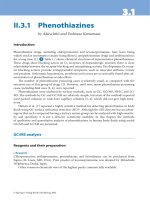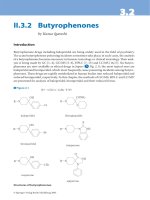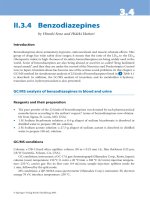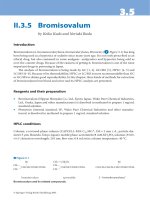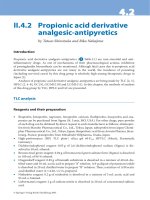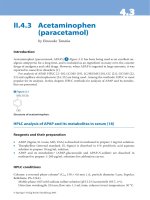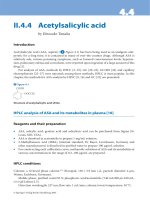Tài liệu Drugs and Poisons in Humans - A Handbook of Practical Analysis (Part 37) pptx
Bạn đang xem bản rút gọn của tài liệu. Xem và tải ngay bản đầy đủ của tài liệu tại đây (186.45 KB, 8 trang )
4.54.5
© Springer-Verlag Berlin Heidelberg 2005
II.4.5 Antiepileptics
by Einosuke Tanaka
Introduction
As antiepileptics, phenytoin, mephenytoin, nirvanol and ethotoin are being used for treat-
ments of grand mal and complex partial seizures. A iminostilbene derivative carbamazepine,
phenobarbital (one of the barbiturates) and some benzodiazepines are also being well used as
antiepileptics (
> Figure 5.1). Poisoning cases due to accidental and suicidal ingestion of these
antiepileptics were reported [1].
For analysis of antiepileptics, methods using HPLC [2–15], LC/MS [16], GC [17, 18] and
GC/MS [19,20] were reported. Among them, HPLC methods are being used most commonly.
In this chapter, two HPLC methods, dealing with analysis of phenytoin and other antiepileptics
together with their metabolites in serum [11] and plasma [15], are presented.
⊡ Figure 5.1
Structures of antiepileptics and their analogs.
352 Antiepileptics
HPLC analysis of antiepileptics in serum [11]
Reagents and their preparation
• Carbamazepine, ethosuximide, phenytoin, primidone, phenobarbital, diazepam, oxaze-
pam, nitrazepam and 5-(4-methylphenyl)-5-phenylhydantoin (internal standard, IS) can
be all purchased from Sigma (St. Louis, MO, USA).
• Each of above drugs is dissolved in methanol to prepare 1 mg/mL solution.
• By diluting the 1 mg/mL solution with methanol, solutions at various concentrations in the
range of 0.05–5 µg/mL are prepared for drugs to be quantitated, because they are used for
constructing each calibration curve.
HPLC conditions
Column: a reversed phase column
a
( TSK gel super-ODS; 100 × 4.6 mm i. d., particle diameter
2 µm, Tohso, Tokyo, Japan).
Mobile phase: acetonitrile/8 mM phosphoric acid aqueous solution (3:7, v/v); its ow rate:
0.6 mL/min; detection wavelength: 215 nm; column (oven) temperature: room temperature.
Procedure
i. A 0.5-mL volume of serum
b
, 100 µL of 0.2 M hydrochloric acid solution, 50 µL of IS solu-
tion and 3 mL dichloromethane are placed in a glass centrifuge tube with a ground-in
stopper.
ii. A er shaking for 1 min, the tube is centrifuged.
iii. e resulting organic phase (lower layer) is transferred to a glass vial with a conical
bottom.
iv. e organic extract is evaporated to dryness under a stream of nitrogen.
v. e residue is dissolved in 100 µL mobile phase.
vi. A xed amount of the above solution is injected into HPLC.
vii. For constructing calibration curves, various concentrations of standard solution are mixed
with 50 µL IS solution each and processed according to the above procedure.
Assessment of the method
> Figure 5.2 shows an HPLC chromatogram for the eight antiepileptics listed in > Figure 5.1,
which had been spiked into human serum. e linearity of each compound could be obtained
in the range of 0.05–1 µg/mL in serum; recovery rates were 96–104 %. e detection limits
were: 0.05 µg/mL for carbamazepine; 0.1 µg/mL for primidone, phenobarbital, phenytoin
c
,
oxazepam, ethosuximide, and nitrazepam; and 0.5 µg/mL for diazepam.
353
HPLC analysis of antiepileptics and some metabolites in plasma [15]
Reagents and their preparation
• Ethosuximide, primidone, phenobarbital, carbamazepine, phenytoin and carbamazepine-
epoxide can be purchased from Sigma. Lamotrigine, carbamazepine-diol and 9-hydroxy-
methyl-10-carbamyl acridan were reported to be obtainable from Chiba-Geigy (Basel,
Switzerland)
d
. ese compounds are dissolved in methanol to prepare 1 mg/mL solution.
• By diluting the methanolic 1 mg/mL solution, various concentrations of some drugs in the
range of 0.5–200 µg/mL are prepared for constructing each calibration curve.
HPLC conditions
Column: a reversed phase column
a
, Supelcosil LC-18 (150 × 4.6 mm i.d., particle diameter
5 µm, Supelco, Bellefonte, PA, USA).
HPLC chromatogram for 8 antiepileptics spiked into human serum [11]. 1: ethosuximide (10 µg/mL,
retention time 2.6 min); 2: primidone (1 µg/mL, 2.7 min); 3: phenobarbital (1 µg/mL, 4.3 min);
4: carbamazepine (1 µg/mL, 6.9 min); 5: phenytoin (1 µg/mL, 8.0 min); 6: oxazepam (1 µg/mL, 9.0 min);
7: nitrazepam (1 µg/mL, 9.6 min); 8: diazepam (1 µg/mL, 28.1 min); 9: 5-(4-methylphenyl)-5-
phenyl hydantoin (IS, 1 µg/mL).
⊡ Figure 5.2
HPLC analysis of antiepileptics and some metabolites in plasma
354 Antiepileptics
Mobile phase: 0.01 M potassium dihydrogenphosphate solution/methanol/acetonitrile
(65:18:17, v/v) (pH 7.5); detection wavelength: 220 nm; ow rate: 1 mL/min: column (oven)
temperature: room temperature.
Procedure
e
i. A 100-µL aliquot of plasma
b
and 20 µL IS solution are mixed for several seconds in a
2-mL volume microtube.
ii. A 1-mL volume of diethyl ether is added to the above mixture.
iii. A er shaking for 5 min, the tube is centrifuged at 1,000 g for 10 min.
iv. e organic phase (upper layer) is transferred to another clean microtube.
v. e phase is evaporated to dryness under a stream of nitrogen.
vi. e residue is dissolved in 100 µL of the mobile phase.
vii. A 20-µL aliquot of the solution is injected into HPLC.
viii. For constructing calibration curves, various concentrations of standard solutions are
mixed with 20 µL IS solution each and processed according to the above procedure.
Assessment of the method
In this method, 6 kinds of antiepileptics ( ethosuximide, primidone, lamotrigine, phenobarbi-
tal, phenytoin and carbamazepine) and two carbamazepine metabolites ( carbamazepine-diol
and carbamazepine- epoxide) can be detected from human plasma (
> Figure 5.3). e detec-
tion limits of each drug was about 0.2 µg/mL; recovery rates were 71–104 %.
Toxic and fatal concentrations in blood [21]
Phenytoin: therapeutic, 7 µg/mL (10–20 µg/mL); toxic, 48 µg/mL (30–60 µg/mL); fatal, not
lower than 70 µg/mL (average 94 µg/mL).
Carbamazepine: therapeutic, 6.4 µg/mL (3.5–9.4 µg/mL): toxic, 10.1 µg/mL (3.2–20.6 µg/
mL); fatal, 19.6 µg/mL.
Ethosuximide: therapeutic, 44 µg/mL (13–71 µg/mL); toxic, 100–200 µg/mL; fatal,
250 µg/mL.
Primidone: therapeutic, 10.5 µg/mL (6–17.8 µg/mL): toxic, 20–50 µg/mL; fatal, 65 µg/mL.
Diazepam: therapeutic, 0.05–2 µg/mL; toxic, 2–5 µg/mL; fatal, not lower than 5 µg/mL.
Phenobarbital: therapeutic, 12.3 µg/mL (4–26.2 µg/mL); toxic, 16.7 µg/mL (3.7–90 µg/mL);
fatal, 45 µg/mL (4.3–120 µg/mL).
Oxazepam: therapeutic, 0.5–2 µg/mL; toxic, not lower than 2 µg/mL; fatal, not clear.
Nitrazepam: therapeutic, 0.044 µg/mL (0.026–0.066 µg/mL); toxic, 0.2 µg/mL (a single
oral intake); fatal, 5.2–9 µg/mL.
355
Poisoning cases
Case 1 [22]: a 85-year-old female su ered from fever, muscle sti ness and itching exanthemas
at home just before admission to a hospital. As her past history, she had experienced hysterec-
tomy, ischemic heart disease and diabetes mellitus (type II). About one month before admis-
sion, she had been diagnosed as complex partial epileptic seizure and had daily taken 300 mg
phenytoin (once at night), 500 mg metformin (twice a day), 500 mg tolbutamide (twice a day),
10 mg nifedipine (twice a day) and 1 mg risperidone (once a day). She had no history of smok-
ing, and had quitted drinking alcohol since the appearance of the epileptic attack. Upon medi-
cal examination for admission to a hospital, she complained of her bad general conditions; her
physical conditions were: body temperature 38 °C, heart beat 90/min and blood pressure
120/70 mmHg. ere were erythematous exanthemas and the characteristic sti ness of the
neck; but neither photophobia nor other pathological neurological ndings were observed.
Antibiotic, corticosteroid and antihistaminic drugs were administered intravenously. All drugs
for oral intake except phenytoin were discontinued on day 3 a er admission. e administra-
tion of phenytoin was also stopped on day 7.
Benzodiazepine antiepileptics were used to control the attack; the functions of the kidney,
liver and heart were aggravated. She died 12 days a er admission. e concentration of blood
phenytoin at admission was 13.6 µg/mL.
Case 2 [23]: a 61-year-old female had been su ering from chronic headache and frequent
vertigo. As a result of clinical tests, a meningioma had been discovered in the le fronto-peri-
HPLC chromatogram for 6 antiepileptics and two metabolites spiked into human plasma [15].
ES: ethosuximide (25 mg/mL, retention time 1.80 min); PR: primidone (2.5 mg/mL, 2.10 min);
CBZ-D: carbamazepine-diol (1 mg/mL, 2.55 min); LTG: lamotrigine (1 mg/mL, 2.95 min);
PB: phenobarbital (5 mg/mL, 3.33 min); CBZ-E: carbamazepine-epoxide (1 mg/mL, 4.48 min);
IS: 9-hydroxymethyl-10-carbamyl acridan (IS, 5.92 min); PT: phenytoin (2.5 mg/mL, 9.45 min);
CBZ: carbamazepine (2.5 mg/mL, 10.2 min).
⊡ Figure 5.3
Poisoning cases
